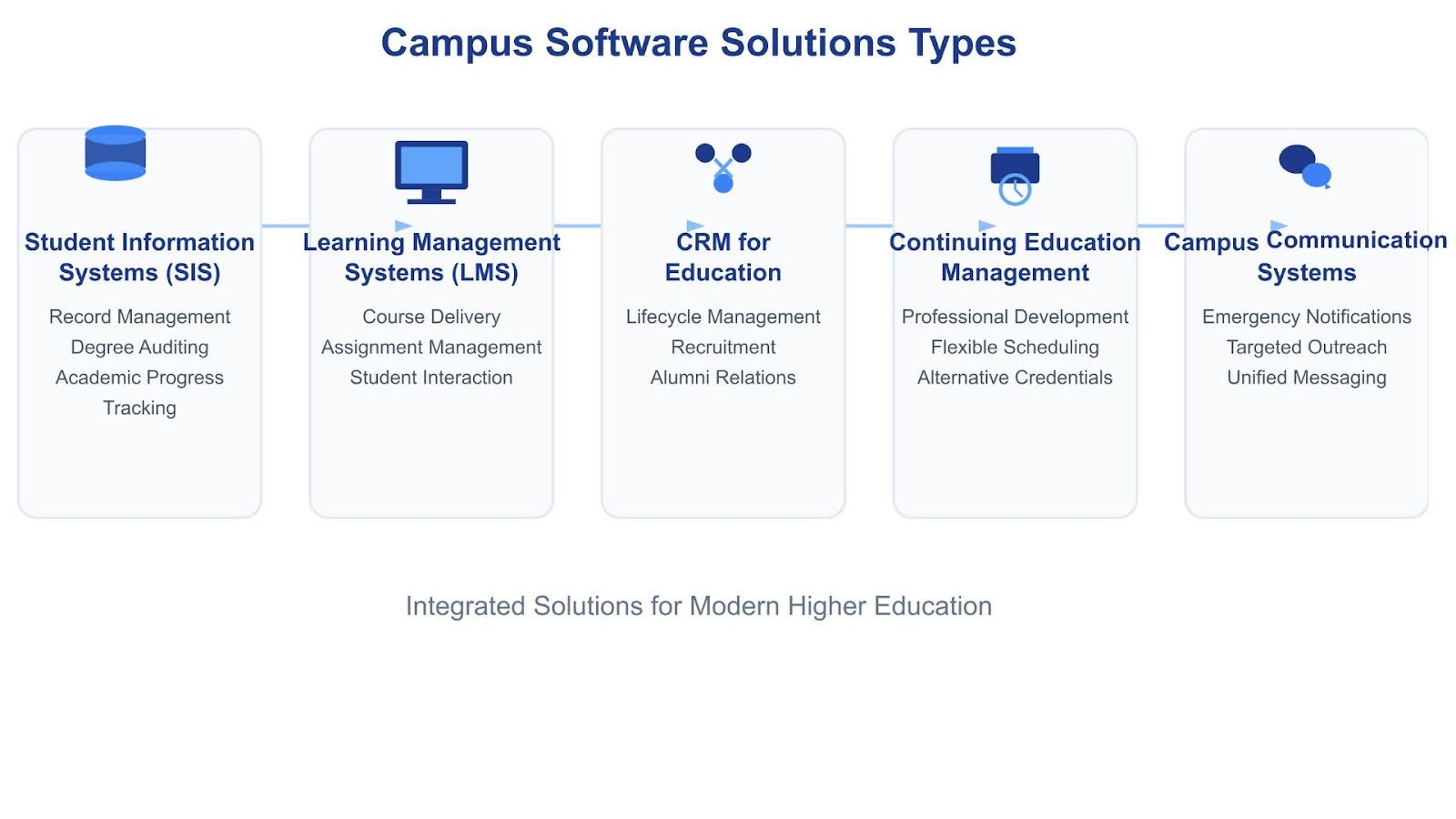Campus management systems are transforming how higher education institutions operate, integrating enrollment, student success and administrative functions into unified platforms.
- Modern systems combine SIS, engagement tools and analytics to support the entire student lifecycle.
- Cloud-based solutions offer scalability, mobile access and real-time data insights.
- Integrated platforms reduce administrative burden while improving student outcomes.
- The right system can increase enrollment, boost retention and streamline campus operations.
Institutions that adopt comprehensive campus solutions see measurable improvements in efficiency and student satisfaction.
Table of Contents:
Running a college or university is complex. Between declining enrollment, evolving student expectations and the constant pressure to do more with less, campus administrators are juggling an overwhelming number of responsibilities. If you're still managing student information through spreadsheets, dealing with disconnected systems that don't talk to each other or watching your staff burn out from repetitive manual tasks, you're not alone.
Campus management systems have evolved beyond record-keeping tools. Today's platforms are comprehensive solutions designed specifically for the unique challenges facing higher education. They're transforming how institutions attract, engage and retain students while making everyone's job easier.
Approximately 70% of North American educational institutions have adopted cloud-based student information systems, with rates continuing to climb as we recognize the operational and financial benefits of modern platforms.
What Are Modern Campus Management Systems?
Campus management systems are integrated software platforms that handle the essential functions of running an educational institution. They're the digital backbone that connects enrollment, academics, student services and administration into one cohesive system.
Here's what makes them different from the clunky legacy systems many institutions still use: modern campus management systems are built specifically for higher education's unique workflow requirements. They understand that a student's journey doesn't follow a straight line from application to graduation. They know that departments need to collaborate seamlessly, that students expect mobile access to their information and that administrators need real-time insights to make informed decisions.
These systems encompass everything from student information management and course scheduling to communication tools and financial aid processing. Rather than forcing your institution to adapt to generic business software, higher ed tools are designed around how colleges and universities actually operate.
Why Do Institutions Need Comprehensive Campus Solutions?
Institutions are dealing with ongoing enrollment challenges, with college enrollment declining steadily since its 2010 peak of 18.1 million students. The latest data shows enrollment finally increased 3% in fall 2024, but retention and financial challenges persist across the sector.
Traditional approaches (separate systems for enrollment, student records, communication and analytics) create more problems than they solve. When your registrar's system doesn't communicate with your enrollment management platform, students fall through the cracks. When your student success team can't access real-time engagement data, intervention efforts come too late. When your marketing team can't track the complete student journey, recruitment strategies miss the mark.
Modern campus software creates unified workflows between departments. These solutions provide a holistic view of each student's experience, from initial inquiry through graduation and beyond. This coordinated approach enables proactive support, evidence-based decision making and the personalized experience students expect.
The financial impact is significant too. Manual processes and disconnected systems waste valuable staff time and create opportunities for errors. Student retention has major financial implications, making technology investments that improve persistence rates critically important for institutional sustainability.
What Features Should Every Campus Management System Include?
The most effective campus software systems share certain core capabilities that directly address higher education's unique needs.
Student Information Management
Any campus system needs robust student information management capabilities. Think beyond basic demographics and transcripts. Modern student management systems track the complete student lifecycle, including engagement patterns, support interactions and behavioral indicators that predict success or risk.
Higher education serves increasingly diverse populations, making comprehensive data management even more essential. Traditional-age students, working adults, part-time learners and those pursuing continuing education or workforce development all have different needs and interaction patterns with the institution. Effective student management systems accommodate these varied pathways while maintaining unified data standards.

Advanced student information management integrates academic records with co-curricular involvement, financial aid status, communication history and program progression tracking. Staff can understand each student's complete experience, whether they're enrolled in a traditional four-year program or pursuing professional development through evening classes, and provide targeted support when needed.
Enrollment and Registration Tools
Enrollment management systems streamline everything from initial inquiry through course registration. These higher ed tools handle complex enrollment scenarios, including transfer credit evaluation, prerequisite checking and schedule optimization.
The best systems also support various enrollment models, from traditional semester-based programs to flexible, competency-based learning paths. They accommodate both degree-seeking students and continuing education participants, recognizing that modern institutions serve diverse learner populations.
Communication and Engagement Platforms
Effective communication is critical for student success, but managing it across multiple departments and platforms creates confusion. Integrated communication tools enable personalized, timely outreach through students' preferred channels, whether that's email, text messaging or mobile app notifications.
These platforms track communication history, preventing duplicate messages and ensuring a consistent institutional voice. They also enable automated campaigns for important milestones like registration deadlines, financial aid requirements and graduation preparations.
Academic Planning and Curriculum Management
Curriculum management capabilities help institutions maintain academic quality while responding to changing industry needs. These higher ed tools streamline course development, approval workflows and program modifications.
Integration with scheduling systems ensures that curriculum changes align with resource availability and student demand. Advanced platforms also provide analytics on course performance, helping identify programs that drive enrollment and those that may need enhancement.
Analytics and Reporting Capabilities
Data is only valuable if you can act on it. Campus management systems should provide intuitive dashboards and reporting tools that translate complex information into actionable insights. They process everything from enrollment forecasting and retention analysis to financial aid utilization and student engagement metrics.
The most powerful analytics capabilities use predictive modeling to identify at-risk students before problems become critical. This foresight enables proactive intervention rather than reactive support.
What Types of Campus Software Solutions Are Available?
Higher education technology encompasses specialized platforms designed to address distinct operational challenges. Understanding these different categories helps institutions build effective technology ecosystems.

- Student Information Systems (SIS): The foundational platform for managing student records, transcripts and academic progress. Modern SIS platforms include degree auditing, prerequisite tracking and seamless integration with other campus systems.
- Learning Management Systems (LMS): Digital platforms that support course delivery, assignment management and student-instructor interaction. While primarily focused on academic content delivery, LMS integration creates unified educational experiences.
- Customer Relationship Management (CRM) for Education: Specialized CRM systems help institutions manage relationships throughout the complete student lifecycle, from prospective students and current learners to alumni engagement and ongoing education opportunities.
- Continuing Education Management: Purpose-built systems for non-traditional programs, professional development and workforce training. These platforms accommodate flexible scheduling, corporate partnerships and alternative credentialing.
- Campus Communication Systems: Unified communication platforms that support everything from emergency notifications to personalized student outreach. These systems ensure consistent messaging while enabling targeted communication strategies across diverse student populations.
How to Choose the Right Campus Management Platform
The right campus software aligns with your institution's culture, goals and operational requirements.
How Should You Assess Your Institution's Specific Needs?
Start by conducting a comprehensive audit of your current processes. Where are the biggest pain points? Which departments struggle most with disconnected systems? What student success metrics need improvement?
Consider your institution's unique characteristics. A community college serving working adults has different requirements than a residential liberal arts college. Similarly, institutions with significant continuing education need different capabilities than those focused primarily on traditional degree programs.
Don't forget to involve key stakeholders in this assessment. Faculty perspectives on academic management differ from staff views on administrative efficiency. Student input on communication preferences and self-service capabilities provides valuable insights.
What Integration Requirements Should You Consider?
Modern campus management systems should integrate seamlessly with your existing technology infrastructure. Consider connections to financial systems, library platforms, housing management and any specialized software your institution already uses.

API capabilities and data standards ensure that information flows smoothly between systems without manual data entry. This integration prevents data silos that create inefficiencies and increase error risk.
Security considerations are equally important. Institutions handle sensitive student information subject to FERPA regulations and other privacy requirements. Any campus management system must include robust security features, regular audits and compliance documentation.
How Do You Ensure Scalability and Future-Proofing?
Your campus management system should grow with your institution. Consider current enrollment, projected growth, new program development and changing educational delivery models.
Cloud-based solutions typically offer better scalability than on-premises systems, enabling institutions to adjust capacity based on enrollment fluctuations and seasonal patterns. They also provide access to regular updates and new features without requiring internal IT resources for maintenance. Modern institutions focus on outcome-oriented metrics that demonstrate ROI and value to students and stakeholders.
Implementation Timeline and Support
Successful implementation requires careful planning and strong vendor support. Look for providers with extensive higher education experience and proven implementation methodologies.
Training and ongoing support are vital for success. Comprehensive training programs, documentation and responsive customer support ensure your investment delivers expected returns.
How Do You Measure Success and ROI of Campus Management Systems?
Student retention software capabilities help identify at-risk students early, enabling intervention strategies that improve persistence rates. Even modest retention improvements generate significant financial returns, given the lifetime value of student enrollment.

Recruitment and yield optimization features support more effective marketing strategies. Institutions using unified platforms often see improvements in application conversion rates, enrollment deposits and overall class size management.
Operational efficiency gains free up staff time for strategic activities. When routine tasks are automated and information is easily accessible, employees can focus on student support, program development and institutional planning rather than data entry and manual reporting.
Enhanced communication improves the student experience while reducing administrative burden. Automated messaging for routine information, self-service portals for common requests and proactive outreach campaigns all contribute to higher satisfaction and improved outcomes.
The most successful implementations also generate valuable intelligence. Analytics capabilities help identify successful programs, optimize resource allocation and support decision-making at all organizational levels.
Frequently Asked Questions
What's the difference between a Student Information System (SIS) and a campus management system? A SIS is primarily focused on academic records and student data management, while campus management systems are comprehensive platforms that include SIS functionality plus enrollment management, communication tools, analytics and other institutional capabilities.
How long does it typically take to implement a new campus management system? Implementation timelines vary based on institutional size and complexity. Factors affecting the timeline include data migration requirements, integration complexity and training needs.
What should institutions consider when evaluating cloud-based vs. on-premises solutions? Cloud-based systems typically offer better scalability, automatic updates and lower upfront costs, while on-premises solutions provide more direct control over data and infrastructure. Most institutions now favor cloud solutions for their flexibility and reduced IT burden.
How can institutions ensure successful user adoption of new campus management systems? Successful adoption requires comprehensive training programs, clear communication about benefits and ongoing support. Involving key users in the selection process and providing role-specific training helps ensure staff and students can effectively use the new system.
Transform Your Institution with the Right Campus Solutions
Higher education is at a crossroads. Institutions that embrace modern campus management systems position themselves for success. Those that continue relying on disconnected, outdated systems will struggle to meet evolving student expectations and operational demands.
The key is finding solutions built specifically for higher education. Look for platforms that integrate seamlessly, scale with your institution's growth and provide the analytics capabilities needed for strategic decision making. Most importantly, choose a vendor that understands higher education and can support your institution's mission of student success.
At Modern Campus, we've spent decades developing solutions designed exclusively for higher education. Our unified platform supports the entire learner-to-earner lifecycle, helping over 1,700 institutions engage modern learners while streamlining operations and enhancing evidence-based decision making. Request a demo today.
Additional Resources

Primer
Student Lifecycle Management and the Learner Experience
Learn how a student lifecycle management platform can transform your learner engagement and customer service.

Whitepaper
How to Increase Continuing Ed Revenue with a Modern eCommerce Experience
Learn how using modern eCommerce principles drives revenue in Continuing Education.

Blog
4 Keys to Increasing Student Engagement in Today’s World
The higher ed ecosystem is changing, especially in regards to student engagement best practices. How institutions adapt will set the stage for the future.